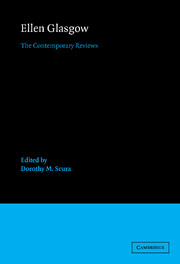Book contents
- Frontmatter
- Contents
- Series Editor's Preface
- Preface
- Acknowledgments
- Introduction
- The Descendant (1897)
- Phases of an Inferior Planet (1898)
- The Voice of the People (1900)
- The Battle-Ground (1902)
- The Freeman and Other Poems (1902)
- The Deliverance (1904)
- The Wheel of Life (1906)
- The Ancient Law (1908)
- The Romance of a Plain Man (1909)
- The Miller of Old Church (1911)
- Virginia (1913)
- Life and Gabriella (1916)
- The Builders (1919)
- One Man in His Time (1922)
- The Shadowy Third and Other Stories (1923)
- Barren Ground (1925)
- The Romantic Comedians (1926)
- They Stooped to Folly (1929)
- The Sheltered Life (1932)
- The Old Dominion Edition of the Works of Ellen Glasgow (1929-33)
- Vein of Iron (1935)
- The Virginia Edition of the Works of Ellen Glasgow (1938)
- In This Our Life (1941)
- A Certain Measure (1943)
- Index
The Shadowy Third and Other Stories (1923)
Published online by Cambridge University Press: 04 May 2010
- Frontmatter
- Contents
- Series Editor's Preface
- Preface
- Acknowledgments
- Introduction
- The Descendant (1897)
- Phases of an Inferior Planet (1898)
- The Voice of the People (1900)
- The Battle-Ground (1902)
- The Freeman and Other Poems (1902)
- The Deliverance (1904)
- The Wheel of Life (1906)
- The Ancient Law (1908)
- The Romance of a Plain Man (1909)
- The Miller of Old Church (1911)
- Virginia (1913)
- Life and Gabriella (1916)
- The Builders (1919)
- One Man in His Time (1922)
- The Shadowy Third and Other Stories (1923)
- Barren Ground (1925)
- The Romantic Comedians (1926)
- They Stooped to Folly (1929)
- The Sheltered Life (1932)
- The Old Dominion Edition of the Works of Ellen Glasgow (1929-33)
- Vein of Iron (1935)
- The Virginia Edition of the Works of Ellen Glasgow (1938)
- In This Our Life (1941)
- A Certain Measure (1943)
- Index
Summary
“The Shadowy Third” New York Times Book Review, 28 October 1923, sec. 3, p. 16
In these days when perturbed spirits refuse to rest, when they obey that impulse for self-expression even to the point of saying it with flowers, it is pleasant to come upon such well-behaved and considerate spooks as those who people the principal stories of Ellen Glasgow's The Shadowy Third. But be it understood that Miss Glasgow refrains from adventuring deliberately into the pseudo-scientific side of psychic phenomena. She merely adopts the device—and in her hands it becomes a highly effective one—of making the dead who continue to live in the memory assume at times a visual form. Miss Glasgow accomplishes the transition so smoothly, and blends the natural with the unnatural so skillfully, that her tales lack entirely the self-consciousness and patent artificiality that one invariably associates with the ghost story. Indeed, the atmosphere and mood in “Whispering Leaves,” for instance, or in “The Past” places the reader in such a receptive state of mind that he accepts the shifting of the image from the mental membrane to the retina as nothing glaringly untoward or even very much out of the way.
“The Shadowy Third” possesses all the well-rounded attributes of the deliberate “plot” story, and the interest centres upon machinations that are of the earthy rather than upon the ethereal visitor. “Whispering Leaves,” on the other hand, shows Miss Glasgow's method developed to its nth power.
- Type
- Chapter
- Information
- Ellen GlasgowThe Contemporary Reviews, pp. 225 - 236Publisher: Cambridge University PressPrint publication year: 1992



